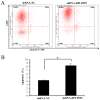Downregulation of lncRNA RPLP0P2 inhibits cell proliferation, invasion and migration, and promotes apoptosis in colorectal cancer
- PMID: 33649783
- PMCID: PMC7974314
- DOI: 10.3892/mmr.2021.11948
Downregulation of lncRNA RPLP0P2 inhibits cell proliferation, invasion and migration, and promotes apoptosis in colorectal cancer
Abstract
Recent studies have revealed that long noncoding RNAs (lncRNAs) are closely associated with colorectal cancer (CRC); however, the role of the lncRNA RPLP0P2 in CRC remains largely unknown. In the present study, RNA expression profiles of CRC were collected from The Cancer Genome Atlas database and the prognosis of CRC with respect to RPLP0P2 was assessed. Subsequently, RPLP0P2 expression was knocked down in the human CRC cell line RKO using a short hairpin RNA (shRNA) lentivirus, and the biological behaviors of the cells, such as proliferation, migration, cell cycle progression and apoptosis, were examined. The results demonstrated that the expression levels of RPLP0P2 were higher in CRC tissue compared with those in normal tissue, and RPLP0P2 was associated with prognosis. RPLP0P2 knockdown significantly decreased cell colony formation, migration and invasion, and arrested CRC cells in the S phase to G2/M phase transition. Furthermore, apoptosis was significantly increased in CRC cells infected with the RPLP0P2 shRNA lentivirus compared with in the control group. In conclusion, RPLP0P2 may promote proliferation, invasion and migration, and inhibit apoptosis of CRC cells, suggesting that RPLP0P2 may function as an oncogene in CRC.
Keywords: RPLP0P2; colorectal cancer; proliferation; apoptosis.
Conflict of interest statement
The authors declare that they have no competing interests.
Figures






Similar articles
-
LncRNA RPLP0P2 Promotes Colorectal Cancer Proliferation and Invasion via the miR-129-5p/Zinc Finger and BTB Domain-Containing 20 Axis.Biochem Genet. 2024 Jun;62(3):1556-1576. doi: 10.1007/s10528-023-10478-7. Epub 2023 Aug 31. Biochem Genet. 2024. PMID: 37651070
-
Silencing of lncRNA EZR-AS1 inhibits proliferation, invasion, and migration of colorectal cancer cells through blocking transforming growth factor β signaling.Biosci Rep. 2019 Nov 29;39(11):BSR20191199. doi: 10.1042/BSR20191199. Biosci Rep. 2019. PMID: 31693738 Free PMC article.
-
LncRNA AB073614 regulates proliferation and metastasis of colorectal cancer cells via the PI3K/AKT signaling pathway.Biomed Pharmacother. 2017 Sep;93:1230-1237. doi: 10.1016/j.biopha.2017.07.024. Epub 2017 Jul 20. Biomed Pharmacother. 2017. PMID: 28738539
-
Recent developments in targeting genes and pathways by RNAi-based approaches in colorectal cancer.Med Res Rev. 2021 Jan;41(1):395-434. doi: 10.1002/med.21735. Epub 2020 Sep 29. Med Res Rev. 2021. PMID: 32990372 Review.
-
Lipid metabolism reprogramming in colorectal cancer.J Cell Biochem. 2023 Jan;124(1):3-16. doi: 10.1002/jcb.30347. Epub 2022 Nov 5. J Cell Biochem. 2023. PMID: 36334309 Review.
Cited by
-
Overview of research progress and application of experimental models of colorectal cancer.Front Pharmacol. 2023 Jul 4;14:1193213. doi: 10.3389/fphar.2023.1193213. eCollection 2023. Front Pharmacol. 2023. PMID: 37469864 Free PMC article. Review.
-
Acrylamide Induces Antiapoptotic Autophagy and Apoptosis by Activating PERK Pathway in SH-SY5Y Cells.Toxics. 2025 Jan 7;13(1):41. doi: 10.3390/toxics13010041. Toxics. 2025. PMID: 39853039 Free PMC article.
-
Predicting Pseudogene-miRNA Associations Based on Feature Fusion and Graph Auto-Encoder.Front Genet. 2021 Dec 13;12:781277. doi: 10.3389/fgene.2021.781277. eCollection 2021. Front Genet. 2021. PMID: 34966413 Free PMC article. Review.
-
RPLP2 activates TLR4 in an autocrine manner and promotes HIF-1α-induced metabolic reprogramming in hepatocellular carcinoma.Cell Death Discov. 2023 Dec 5;9(1):440. doi: 10.1038/s41420-023-01719-0. Cell Death Discov. 2023. PMID: 38052785 Free PMC article.
-
Crosstalk between non-coding RNAs and programmed cell death in colorectal cancer: implications for targeted therapy.Epigenetics Chromatin. 2025 Jan 15;18(1):3. doi: 10.1186/s13072-024-00560-8. Epigenetics Chromatin. 2025. PMID: 39810224 Free PMC article. Review.
References
MeSH terms
Substances
LinkOut - more resources
Full Text Sources
Other Literature Sources
Medical

